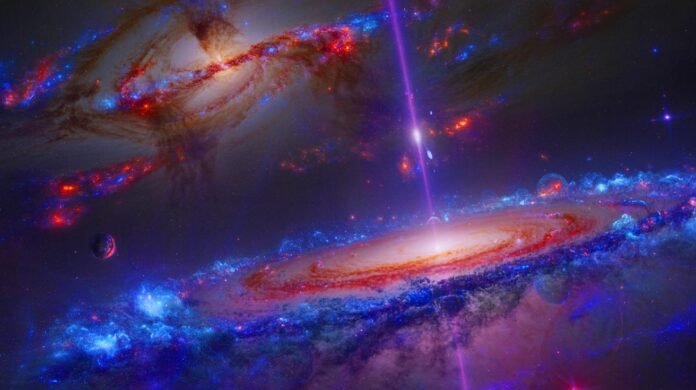| IN A NUTSHELL |
|
The universe has long held a tantalizing mystery: the whereabouts of its missing “normal” matter, known as baryonic matter. Unlike the elusive dark matter, baryonic matter consists of the tangible materials that build stars, planets, and even ourselves. For decades, cosmological models suggested a certain amount of this matter should exist, yet observable data accounted for only half. Now, through sophisticated observational techniques using fleeting light signals from the universe’s edge, researchers believe they have cracked the case. Astonishingly, the missing matter was right between the galaxies all along.
The Mystery of Vanishing Baryonic Matter
In the realm of cosmic mysteries, the enigma of missing baryonic matter stood apart. This isn’t about dark matter, the shadowy substance that doesn’t interact with light. Rather, it’s about the baryonic matter, the familiar atoms, protons, and neutrons that form the tangible universe. Modern cosmological equations, especially those derived from studying the cosmic microwave background, estimate the universe’s total baryonic matter. Yet, astronomers could only trace about half of it, scattered across stars, galactic gas, and clusters. The rest seemed to have vanished into the cosmic void.
This conundrum baffled scientists, leading to theories about where this missing matter might reside. The prevailing hypothesis was that it lingered in the vast expanses between galaxies, an area known as the intergalactic medium. However, this matter was elusive, detectable neither by optical nor infrared telescopes. It called for an unconventional method of discovery, one that turned to celestial phenomena as unlikely allies.
The Intergalactic Medium: A Long-Suspected Culprit
For years, scientists suspected that the missing baryonic matter resided in the intergalactic medium (IGM), a sprawling network of hot, diffuse gas that forms the cosmic web connecting galaxies. However, detecting this matter proved challenging. The gas was so thinly spread that it eluded optical, infrared, and X-ray telescopes. Scientists needed an indirect method to reveal its presence, and that’s where the enigmatic fast radio bursts (FRBs) entered the picture.
FRBs are brief but intense radio wave bursts originating from distant galaxies. Despite their fleeting nature—lasting only milliseconds—their energy output rivals the Sun’s over several days. As these signals traverse the universe, they interact with free electrons, causing a delay that can be measured. This delay acts like a cosmic sonar, allowing scientists to infer the amount of baryonic matter the signal has passed through, shedding light on the elusive IGM.
Cosmic Flashes: Scanning the Universe with FRBs
First discovered in 2007, fast radio bursts (FRBs) have become invaluable tools for astronomers. These intense radio wave flashes, originating from galaxies millions to billions of light-years away, are brief yet powerful. In just milliseconds, an FRB can release as much energy as the Sun does in several days. Their brevity and energy make them excellent cosmic probes.
As FRBs travel across the universe, their signals become dispersed by free electrons encountered along their path. By measuring this dispersion, scientists can calculate the amount of baryonic matter the signal has intersected. This innovative approach effectively uses FRBs as a cosmic radar, mapping the unseen baryonic matter and confirming its presence in the intergalactic medium. This breakthrough reveals a previously hidden aspect of the universe, offering new insights into cosmic structure.
A Pivotal Observation Campaign
Recently, an international research team, led by astrophysicists from the Harvard-Smithsonian Center for Astrophysics and Caltech, analyzed 60 FRBs detected by cutting-edge radio telescopes. These bursts originated from a range of distances, from 11 million to over 9 billion light-years away. By examining their signals, scientists reconstructed the baryonic matter distribution across vast cosmic expanses.
The findings were striking: approximately 76% of all baryonic matter resides in the intergalactic medium, as hot, diffuse gas. The rest is distributed among galaxy halos (about 15%) and dense regions like stars or cold clouds. This discovery not only solves a long-standing cosmic puzzle but also provides a clearer understanding of galaxy evolution. It suggests that supernova explosions and supermassive black holes eject significant gas amounts into the IGM, influencing galaxy formation and star production.
The groundbreaking discovery of the universe’s missing baryonic matter in the intergalactic medium marks a new era in cosmology. It confirms long-held theories and opens new avenues for exploration. As we harness the power of fast radio bursts and next-generation observatories, our understanding of the universe will deepen, unveiling more of its secrets. How will these findings reshape our comprehension of cosmic evolution and the universe’s intricate web of matter?
Our author used artificial intelligence to enhance this article.
Did you like it? 4.4/5 (28)






